Mycotoxin exposure can compromise gut integrity, liver health, and immune system function. This year, levels of mycotoxins in corn in some regions are high enough to significantly impact farm profits, so mitigation in early stages and grower diets is important.
May 26, 2020
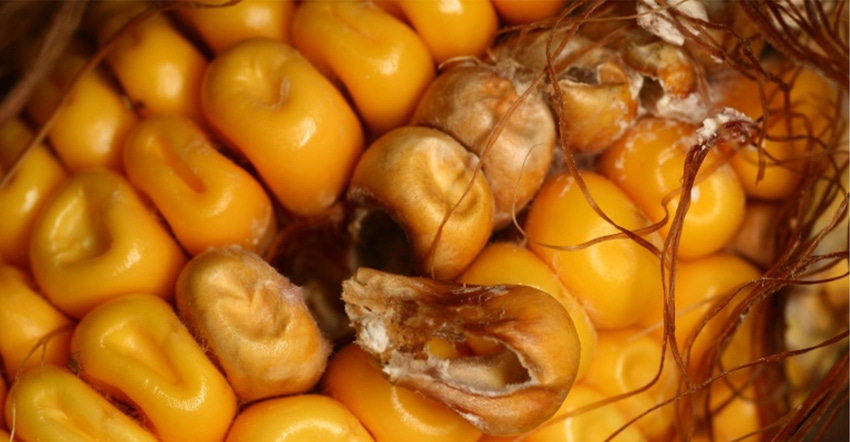
Sponsored Content
Today the livestock industry is facing unprecedented challenges. Supply chain disruptions, painful lows for live animal prices, and bottlenecks due to plant closures are resulting in drastic economic losses for producers. Due to these extenuating market conditions, we find ourselves with dumped milk, austere diets with goals of slowing down animal growth, and depopulation and euthanasia of healthy animals. On top of these difficult and fluctuating market conditions, the livestock industry is enduring a production year with significantly mycotoxin-contaminated corn.
This year’s corn crop in the United States has had a high prevalence of three toxins produced by the Fusarium species of fungus: type B trichothecenes (B-Trich), such as deoxynivalenol (DON), commonly known as vomitoxin; fumonisin (FUM); and zearalenone (ZEN). The last three years have had an increasing trend of prevalence and contamination levels of these mycotoxins (Figure 1 and 2), and mycotoxin mitigation has been a key component of reducing risks to animal health and performance, especially in particularly hard-hit states such as Nebraska, Kansas, and Wisconsin (full report can be found at www.biomin.net/us/survey).
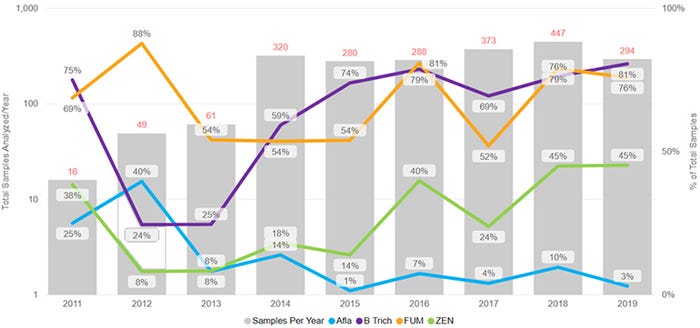
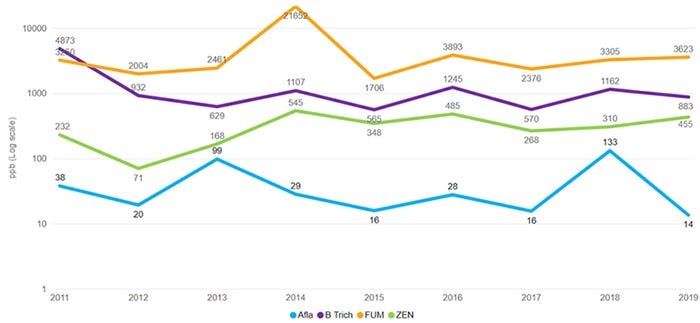
Currently, mitigation is a fine balance between surviving the reality of the economic challenges without sacrificing opportunities of the future. Consequences of mycotoxin exposure can have varying long-term impacts on production systems at each stage of life, from breeding stock to market animals.
Protecting Breeding Stock and Replacement Animals
Although the national breeding herds for swine will likely contract in the short term, scaling up with high potential sows will be the key to take advantage of future market improvements. In order to do so, ensuring that replacement gilts are protected from the negative effects of mycotoxins is necessary for safeguarding a future high-performing sow herd. Zearalenone can cause damage to oocytes at levels as low as 250 ppb, even when fed for short periods of time (Acda et al., 2008). Recent research has implicated DON can have toxic impacts on sow ovaries as well (Gerez et al., 2017).
Although academic research of mycotoxins on the reproduction of ruminants and poultry is sparse, mycotoxins have been reported to negatively impact reproductive performance. Protection of broiler breeders is important to ensure flexibility downstream. Additionally, for table egg production, protecting layers is likely of economic value as long as distribution channels are working well for producers.
Reproductive success for beef and dairy cows is critical for optimal production and profitability. Mycotoxins, namely ZEN and DON, can impose severe reproductive complications that may impair regular heat cycles, breeding, and the ability to maintain pregnancies. Without mitigating the negative effects of mycotoxins, producers are at a greater risk for increased calving intervals or more open cows.
Production Animals
Mycotoxin risk management in animals finishing to market is, for many, not worth the return on investment in the current market. Each production system needs to evaluate their individual risks, and what tolerance their balance sheet has for losses due to mycotoxicosis. In states such as Nebraska and Missouri, levels of mycotoxins in corn crops are high enough to contribute to mortality in farms, especially if respiratory disease is present. Partial mitigation throughout, or potentially mitigation in earlier starter or grower diets may strike the balance of maintaining animal health while being frugal on feed budget.
Mitigation Strategies
When a mycotoxin risk management program is implemented, it is essential to use the proper intervention for the particular issue at hand and utilize strategies with peer-reviewed information demonstrating efficacy. Overall, mycotoxin exposure can significantly compromise gut integrity, liver health, and immune system function. Research into components of plant and algal origin show promising results in supporting these organ systems through toxic exposures, and should be considered as a strategy within mycotoxin mitigation solutions (Galvano et al., 2001; Peng et al., 2009; Fathallah et al., 2013).
In areas where adsorption is a reasonable intervention, such as high FUM prevalence, high-quality clays can be an excellent option. However, since not all clays are the same, understanding the source of clay in a particular product and evaluations of efficacy are essential (Murugesan et al, 2015; Zhao et al, 2019).
Where there is a DON and/or ZEN challenge, adsorption is not an adequate solution since clays have demonstrated poor adsorption (a mean of 5%) of DON (Murugesan et al., 2015), and moderate adsorption of ZEN (Fruhauf et al., 2012). Alternative strategies such as biotransformation, where toxins can be enzymatically and permanently inactivated are much more effective (Hahn et al., 2015; Gott et al., 2019). Results from a study utilizing an in-vitro rumen batch model demonstrates how biotransformation can inactivate DON (Figure 3) and ZEN (Figure 4) (Gott et al., 2019). After three hours, DON was reduced by 87% and ZEN by 91%, and no mycotoxins were detected by 6 hrs.
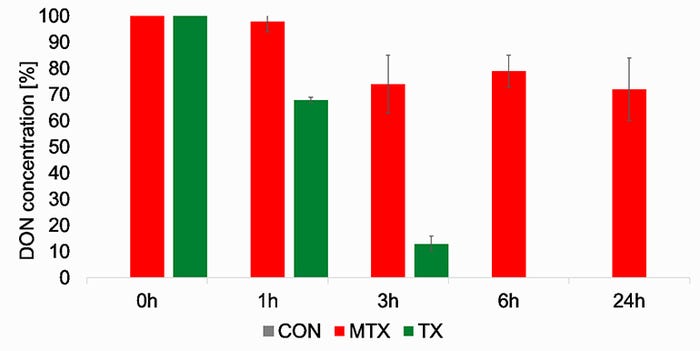
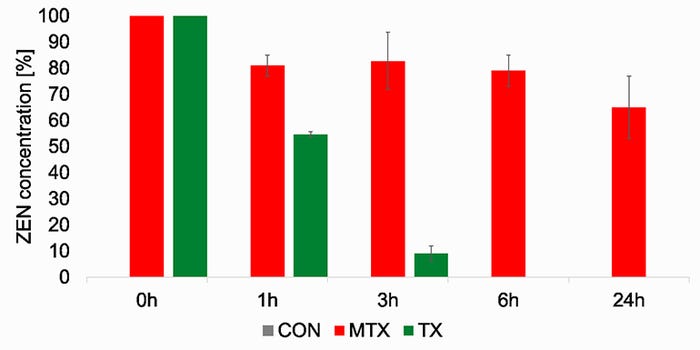
During extremely challenging markets, not addressing mycotoxin risk management can lead to exacerbating economic losses for producers. Strategic application of effective interventions are critical to ensure resilience for short term and long term objectives for animal health and performance.
References
Acda, S., M.R. Batungbacal, J.R. Centeno, N.F. Carandng. (2008). Effects of mycotoxin deactivating agent on the growth performance of pigs fed ochratoxin and zearalenone-contaminated diets. Philipp. J. Vet. Med, 45:14-21.
Fathallah, S., Mohamed, A., Jun, H., Kim, D. (2013). Protective Effect of Dates (Phoenixdactylifera L.) and Licorice (Glycyrrhizaglabra) on Carbon Tetrachloride–Induced Hepatotoxicity in Dogs. J. of Vet. Med. Research, 22(1), 8-9. doi: 10.21608/jvmr.2013.77672
Fruhauf, S., H. Schwartz, F. Ottner, R. Krska, and E. Vekiru. (2012). Yeast cell based feed additives: studies on aflatoxin B1 and zearalenone. Food Addit. Contam. Part A 29:217-231. doi: 10.1080/19440049.2011.630679
Galvano, F., Piva, A, Ritieni, A., Galvano, G. (2001) Dietary Strategies to Counteract the Effects of Mycotoxins: A Review. Journal of Food Protection. Vol. 64, No. 1: 120-131.
Gerez, J. R., S. S. Desto, and, A. P. F. R. L. Bracarense. (2017). Deoxynivalenol induces toxic effects in the ovaries of pigs: an ex vivo approach. Theriogenology, 90, 94-100.
Gott, P.N., U. Hofstetter, D. Schatzmayr, and G.R. Murugesan. (2019). Detoxification of zearalenone and deoxynivalenol by Biofix Plus PRO in a molasses-based liquid feed supplement in an in vitro rumen batch culture system. J. Anim. Sci. 97 (Suppl. 3):197-198 (Abstr PSV1-9).
Hahn, I., E. Kunz-Vekiru, M. Twarużek, J. Grajewski, R. Krska, and F. Berthiller. (2015). Aerobic and anaerobic in vitro testing of feed additives claiming to detoxify deoxynivalenol and zearalenone. Food Addit. Contam. Part A 32:922-933. doi: 10.1080/19440049.2015.1023741
Murugesan, G. R., D. R. Ledoux, K. Naehrer, F. Berthiller, T. J. Applegate, B. Grenier, T. D. Phillips, and G. Schatzmayr. (2015). Prevalence and effects of mycotoxins on poultry health and performance, and recent development in mycotoxin counteracting strategies.
Poult. Sci. 94:1298-1315. doi: 10.3382/ps/pev075
Peng, H.Y, Chu, Y.C., and Chou, S.T. (2009) Hepatoprotection of chlorella against carbon tetrachloride-induced oxidative damage in rats. In vivo, vol. 23 no. 5: 747-54.
Rao, Z. X., M. D. Tokach, S. S. Dritz, J. C. Woodworth, J. M. DeRouchey, R. D. Goodband, and H. Calderon Cartagena. (2019). Efficacy of Commercial Products on Growth Performance of Nursery Pigs Fed Diets with Fumonisin-Contaminated Corn. Kansas Agricultural Experiment Station Research Reports: Vol. 5: Iss. 8. https://doi.org/10.4148/2378-5977.7844
About the Author(s)
You May Also Like


.png?width=300&auto=webp&quality=80&disable=upscale)
